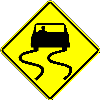Global Navigation

Main Navigation
Sub-Navigation

Content
So it is with traction, except there is no alternative means of paying. Yes, we can put on new tires to improve our traction or we can pick a better road to ride on that will give us more traction or we can wait until it stops raining and the roads dry up so we have better traction, but all of these actions take time like writing a check or going to the ATM. When traction is needed it's got to be there, ready for use. We can't carry a supply in our saddlebags just in case we run out. Traction won't fit in that secret hiding place in our wallet like that "mad money" can. The bottom line is, when we try to use more traction than we have available from the friction between our tires and the road surface, the tire will break free and slide or spin.
So what does traction do for us? Why is traction such a concern to us? Because there is a limited amount of traction available to us, we must understand how that traction is used. That's where the ABC's of traction come in. There are three distinct consumers of traction when we ride. Traction is used for Acceleration, Braking and Cornering. Let's look at each of these individually.
One user of traction – Accelerating
The first of the traction users we'll look at is acceleration. When we roll on the throttle and apply power to the rear wheel, we expect our bike to accelerate. It does this because of the friction between the tire and the road moves our bike forward. This is acceleration force, one of the users of traction. If we try to accelerate too hard, using more traction than is available, the rear wheel spins. We've probably all experienced this problem when we've been sitting in some car droppings or on gravel and try to take off quickly.
Sidebar
Footer
Copyright 1996-2015 Chuck Miles All Rights Reserved
All information on this site, including all articles, are copyrighted materials belonging to Chuck Miles.
Design: Made in Austria | Author: G. Wolfgang



